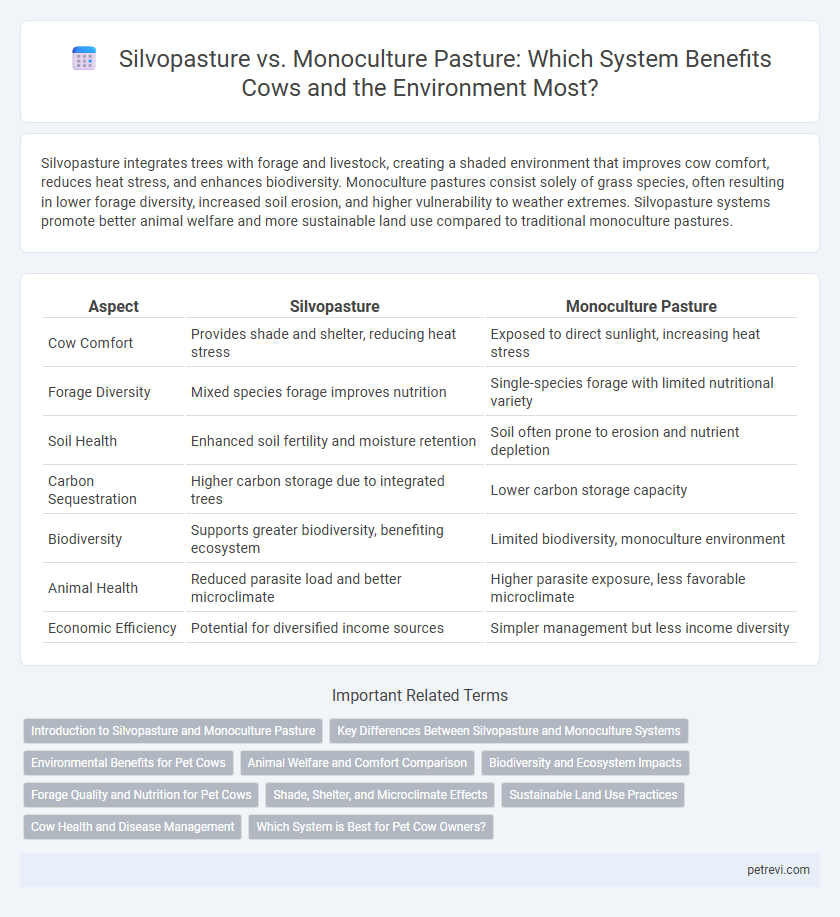Silvopasture integrates trees with forage and livestock, creating a shaded environment that improves cow comfort, reduces heat stress, and enhances biodiversity. Monoculture pastures consist solely of grass species, often resulting in lower forage diversity, increased soil erosion, and higher vulnerability to weather extremes. Silvopasture systems promote better animal welfare and more sustainable land use compared to traditional monoculture pastures.
Table of Comparison
| Aspect | Silvopasture | Monoculture Pasture |
|---|---|---|
| Cow Comfort | Provides shade and shelter, reducing heat stress | Exposed to direct sunlight, increasing heat stress |
| Forage Diversity | Mixed species forage improves nutrition | Single-species forage with limited nutritional variety |
| Soil Health | Enhanced soil fertility and moisture retention | Soil often prone to erosion and nutrient depletion |
| Carbon Sequestration | Higher carbon storage due to integrated trees | Lower carbon storage capacity |
| Biodiversity | Supports greater biodiversity, benefiting ecosystem | Limited biodiversity, monoculture environment |
| Animal Health | Reduced parasite load and better microclimate | Higher parasite exposure, less favorable microclimate |
| Economic Efficiency | Potential for diversified income sources | Simpler management but less income diversity |
Introduction to Silvopasture and Monoculture Pasture
Silvopasture integrates trees, forage, and livestock, creating a diversified environment that enhances animal welfare and soil health compared to monoculture pasture systems. Monoculture pasture consists of a single forage species, often leading to soil degradation and reduced biodiversity, which can negatively impact cow comfort and productivity. Implementing silvopasture improves shade availability, reduces heat stress in cows, and promotes carbon sequestration, fostering a more resilient and sustainable grazing system.
Key Differences Between Silvopasture and Monoculture Systems
Silvopasture integrates trees, forage, and livestock, enhancing biodiversity and providing shade, which improves cow comfort and reduces heat stress, unlike monoculture pasture that consists solely of single-species forage. This agroforestry system promotes better soil health through increased organic matter and root diversity, leading to higher carbon sequestration compared to the more degraded soils often found in monoculture pastures. Silvopasture also supports greater habitat complexity and microclimate regulation, offering environmental benefits and improved animal welfare that monoculture systems typically lack.
Environmental Benefits for Pet Cows
Silvopasture enhances cow environments by integrating trees and pasture, promoting biodiversity and improving air quality for pet cows. This method increases shade, reducing heat stress and boosting cow comfort compared to monoculture pastures. Soil health in silvopasture systems benefits from better nutrient cycling and erosion control, supporting sustainable grazing conditions for pet cows.
Animal Welfare and Comfort Comparison
Silvopasture systems, integrating trees with pasture, improve cow welfare by providing shade, reducing heat stress, and enhancing natural shelter compared to monoculture pastures. The diverse vegetation in silvopasture supports better soil health and forage quality, promoting healthier grazing conditions and reducing parasite loads. In contrast, monoculture pastures often expose cows to direct sunlight and harsh weather, limiting their comfort and increasing vulnerability to environmental stressors.
Biodiversity and Ecosystem Impacts
Silvopasture integrates trees with pastureland, enhancing biodiversity by providing varied habitats and promoting ecosystem services such as carbon sequestration and soil health improvement, unlike monoculture pastures that often lead to reduced species diversity and increased soil degradation. The diverse plant structures in silvopasture support a wider range of insects, birds, and microbial life, fostering a balanced ecosystem that benefits cow welfare and productivity. In contrast, monoculture pastures typically experience higher erosion rates and lower resilience to pests and climate extremes, negatively impacting long-term pasture sustainability.
Forage Quality and Nutrition for Pet Cows
Silvopasture systems enhance forage quality by integrating trees with pasture, providing shade that reduces heat stress and increases nutrient density in forage for pet cows. Compared to monoculture pastures, silvopasture promotes biodiversity, resulting in higher protein content and improved fiber digestibility for optimal cow nutrition. This system supports better animal health and growth rates while maintaining sustainable forage production.
Shade, Shelter, and Microclimate Effects
Silvopasture systems integrate trees with grazing land, providing essential shade and shelter that reduce heat stress and protect cows from extreme weather, enhancing animal welfare and productivity. The presence of trees improves the microclimate by moderating temperature fluctuations, increasing humidity, and reducing wind speed, which helps maintain a more stable and comfortable environment for cattle. In contrast, monoculture pastures lack these benefits, often exposing cows to direct sunlight and harsh weather conditions that can lead to decreased feed intake and lower milk production.
Sustainable Land Use Practices
Silvopasture integrates trees with pasture, enhancing biodiversity and improving soil health, which supports sustainable land use by reducing erosion and increasing carbon sequestration. Monoculture pasture, often dominated by a single grass species, can lead to soil degradation and decreased resilience to climate variability. Implementing silvopasture systems promotes a more balanced ecosystem for cows, improving forage quality and providing shade that reduces heat stress.
Cow Health and Disease Management
Silvopasture integrates trees, forage, and livestock, creating a microclimate that reduces heat stress and promotes cow health by enhancing natural shade and shelter. This system improves disease management by decreasing parasite loads through improved soil health and biodiversity, contrasting with monoculture pastures that often encourage pathogen buildup and higher parasite prevalence. Cows in silvopasture systems experience lower incidences of respiratory and heat-related illnesses due to enhanced environmental conditions.
Which System is Best for Pet Cow Owners?
Silvopasture systems integrate trees with pasture, providing shade, improved forage diversity, and enhanced animal welfare, which benefits pet cow owners by reducing heat stress and promoting natural behaviors. Monoculture pastures, while simpler to manage, often lack environmental enrichment and can expose cows to extreme weather without shelter. For pet cow owners seeking optimal comfort and health, silvopasture offers a more sustainable and welfare-friendly environment.
Silvopasture vs Monoculture Pasture for Cow Environment Infographic

 petrevi.com
petrevi.com